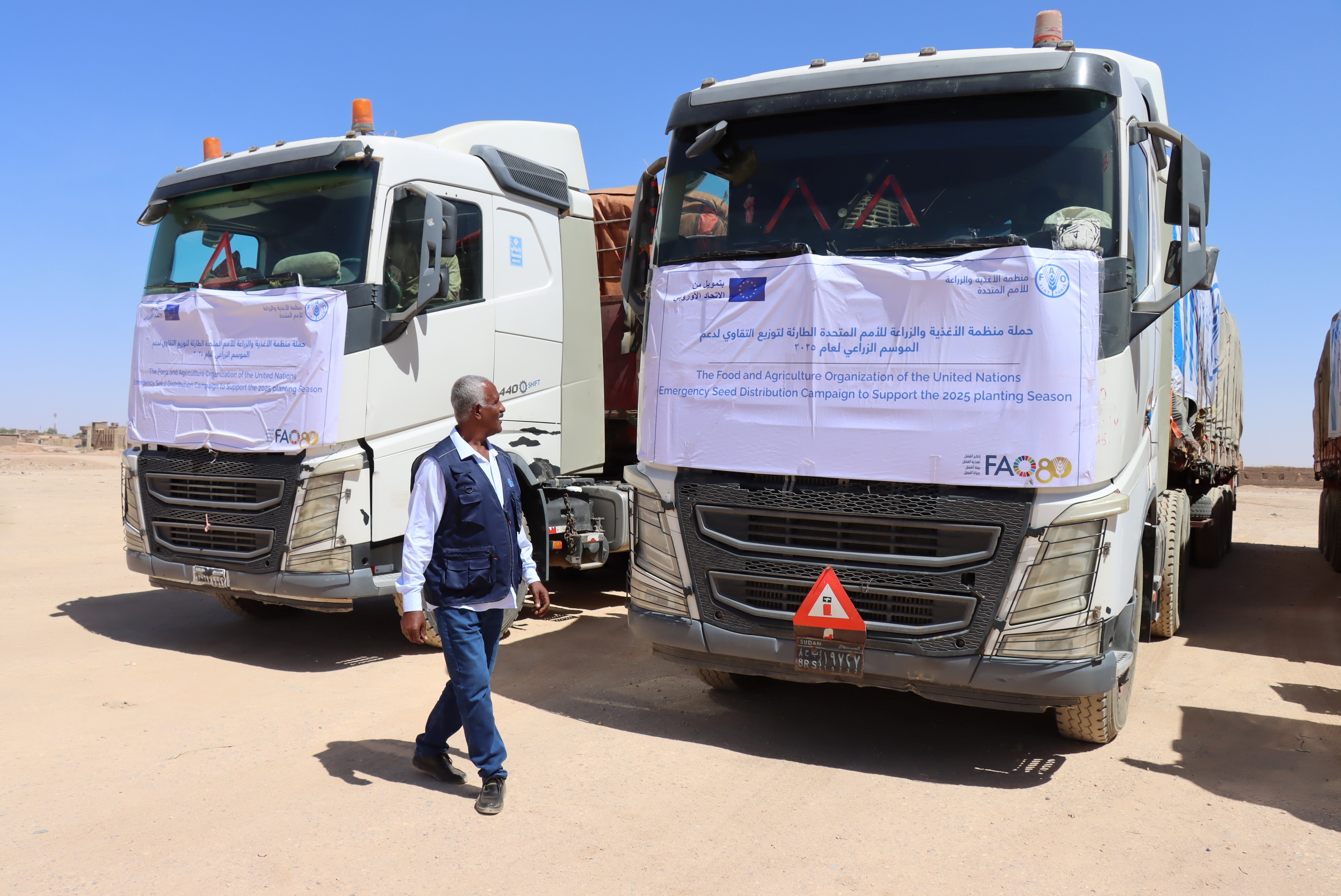Sudan: FAO scales up emergency response with seed distribution campaign targeting 7.5 million people
A vital initiative to boost local food production and restore livelihoods amid ongoing conflict

FAO seed trucks line up, heading to Kordofan to support the 2025 planting season.
©FAO/Abdelrahman Taha
Rome/Port Sudan – The Food and Agriculture Organization of the United Nations (FAO) has launched a large-scale emergency seed distribution campaign targeting 1.5 million farming households – or approximately 7.5 million people – across 17 out of Sudan’s 18 states.
The 2025 seed distribution campaign kicked off in West Darfur, where more than 750 000 people – over half the population – are facing crisis-level hunger or worse due to conflict and food insecurity. FAO is providing urgently needed sorghum, millet, chickpea, and pigeon pea seeds to help families plant for the 2025 main cropping season. Supported by the United Nations’ Central Emergency Response Fund (CERF), Switzerland, Qatar Fund for Development through Education Above All, and the European Union, this campaign complements FAO’s broader emergency response across agriculture and livestock sectors.
“Plant seeds mean growing hope for food. This is not just a hunger crisis – it is a race against time to save lives,” said QU Dongyu, FAO Director-General. “We must act swiftly and decisively so that those in greatest need can quickly produce food they need to survive.”
Escalating violence fuels deepening food insecurity crisis
Sudan’s humanitarian crisis has reached catastrophic levels. According to the latest Integrated Food Security Phase Classification (IPC) analysis released in December 2024, half the population—24.6 million people—is facing high levels of acute food insecurity (IPC Phase 3 or above). Famine (IPC Phase 5) has been declared in five areas by the IPC Famine Review Committee, affecting 637 000 people, with projections indicating it could spread to five more.
The latest Hunger Hotspots report ranks Sudan among the top five hotspots of highest concern. Communities are either experiencing famine, at risk of famine, or are facing catastrophic levels of acute food insecurity driven by escalating conflict, ongoing economic shocks, and natural hazards. These crises are further compounded by increasing access constraints and significant funding shortfalls.
FAO’s frontline response to a worsening crisis
Since June 2025, FAO and its resource and implementing partners have distributed nearly 1000 metric tonnes of sorghum, millet and okra seedsacross Central, West, East and South Darfur States. In addition, FAO is procuring more than 3,000 metric tonnes of crop seeds to support nearly 330 000 households, benefiting over 1.6 million people.
FAO is also ramping up its veterinary response, with plans to vaccinate 8 million animals owned by 3 million people across Sudan – a vital lifeline for rural communities where livestock are critical for food and income.
Despite the urgency, the response remains critically underfunded. FAO requires more than $156.7 million to reach over 14 million people with life-saving support in 2025. To date, only $4.1 million has been secured, leaving a staggering $152.6 million funding gap.
FAO’s seed distribution is one of the most cost-effective and impactful humanitarian responses to the hunger crisis in Sudan, enabling people not only to survive but to sustain themselves with dignity by producing their own food and rebuilding livelihoods. But without urgent, scaled-up humanitarian action—including emergency agricultural support and unimpeded access to conflict-affected communities—the crisis will only deepen.
Contact
Irina Utkina FAO News and Media (Rome) +39657052542 [email protected]
FAO News and Media (+39) 06 570 53625 [email protected]
